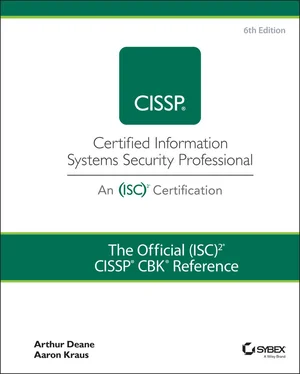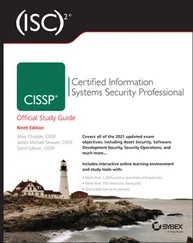1 ...7 8 9 11 12 13 ...35 Review the organization's personnel security policies to identify potential issues or concerns. For example, your company may have compliance requirements to conduct a specific type of background check, and the target company may not be compliant.
Identify any proprietary or custom applications managed by the company and request static and dynamic application security tests be run against them to demonstrate their security posture. (SAST and DAST are covered in Chapter 8, “Software Development and Security.”)
Request results from a recent penetration test (pentest) that includes network, operating system, application, and database testing. Any critical or high findings should have a plan for remediation or mitigation.
Review the organization's use of third-party and open-source software to ensure that the software is safe and appropriately licensed.
The previous list is not intended to be comprehensive, but rather a starting point for things to consider prior to any mergers and acquisitions. Your security team needs to be an integral part of the M&A process from the initial talks through integration.
A divestiture is the act of selling off or disposing of a subset of business interests or assets. An organization may pursue a divestiture for a number of reasons: political, social, or strictly financial. Divestitures often occur when management decides that a certain part of the business no longer aligns with the company's business strategy or mission. Divestitures also frequently happen after a merger or acquisition, in cases where the merger or acquisition creates redundancies within the combined organization.
Information usually accompanies the physical assets and interests that a company divests, which presents a major concern for information security. The biggest security concern in a divestiture involves maintaining confidentiality as the company gets rid of assets that may contain sensitive or proprietary information. As a CISSP, you should ensure that your organization takes the following actions prior to completing a divestiture:
Identify and categorize all assets that are involved in the divestiture; this includes hardware, software, and information assets. Creating a complete inventory of all impacted assets is a critical first step to ensuring a secure divestiture.
Decouple impacted systems from your remaining infrastructure. Your company likely uses common human resources (HR), accounting, and technology systems (such as a virtual private network, email, etc.) to support the entire company. The assets being divested must be removed from this common infrastructure and spun out for the new organization to own and manage.
Review all access permissions. You must identify who has access to the impacted assets and determine whether they need to maintain that access. People are sometimes part of a divestiture, and a subset of the employee base may leave with other divested assets. If that is the case in your divestiture, you must appropriately revoke unnecessary permissions while leaving required permissions intact.
Consult your legal and compliance teams to ensure that you follow all required regulatory and compliance requirements around data retention, deletion, etc.
During a divestiture, both companies (i.e., the divesting and the divested company) must consider how the business transaction impacts their respective security program. Each company must ensure that their security controls, operations, policies and procedures, and governance structure continue to support the newly restructured companies. If the divested company was sold to another company (i.e., as part of an acquisition), then the purchasing company must update its security program to accommodate for its newly acquired assets. In cases where a divested company leads to the formation of a completely new entity, the new company must create an all-new security function (and the supporting policies, procedures, and governance structure) to appropriately manage information security.
Much like mergers and acquisitions, divestitures can present a number of security challenges for organizations. Similarly, the key to a successful divestiture is active involvement by your security team from the early planning phases all the way through completion of the divestiture.
Organizational Roles and Responsibilities
People who don't work in security often look at security professionals as the only employees responsible for keeping systems and information secure. Of course, as information security professionals, we know that it is really everyone's job to keep the organization's assets and information secure — that means from the chief executive officer (CEO) down to the most junior clerk in the mailroom, and everyone in between. As a CISSP, one of your jobs is to evangelize security throughout your company, while helping to define security roles and responsibilities throughout the organization.
Your organization should define security roles and responsibilities within your information security policy, and it should align with roles and responsibilities defined in other organizational policies. It's important that roles and responsibilities are defined for and understood by employees of every level and line of business, as well as third parties such as contractors and vendors.
Different companies have different roles, but the following designations are some of the most commonly seen information security roles:
Chief information security officer (CISO): A CISO is the senior-level executive within an organization who is responsible for the overall management and supervision of the information security program. The CISO drives the organization's security strategy and vision and is ultimately responsible for the security of the company's systems and information. While corporate reporting structures vary by company size and industry, most CISOs now report to a company's chief information officer (CIO) or CEO.
Chief security officer (CSO): A CSO is a senior-level executive within an organization who is generally responsible for all physical security and personnel security matters. Many organizations have merged CSO responsibilities into the CISO role, but you should be aware of the potential distinction between the two. To make matters even more confusing, some organizations refer to their overall security leader as a CSO (instead of CISO). You should lean on context anytime you see these titles used.
Security analyst: A security analyst is someone with technical expertise in one or more security domains who executes the day-to-day security work. This may include things such as data analysis, firewall rule management, incident handling, and other operational activities.
Manager or program manager: In security, a manager (or program manager) is someone who owns one or more processes related to information security. A security manager may be the owner for compliance, vulnerability management, or any other broad set of responsibilities that are executed by security analysts.
Director: In security, a director is generally a manager of managers who is responsible for the overall strategic guidance of a group of security programs.
NOTEWhile the role of CISO has traditionally reported to a company's CIO, that trend is changing. Organizations increasingly view information security as not only an IT issue but a business issue. As a result, many argue that CISOs should report directly to a company's CEO.
As previously mentioned, security is everyone's responsibility. Outside of the information security roles and responsibilities described in the previous list, every user within an organization plays an important role in keeping information secure. A user (or end user ) includes any person who accesses or handles an organization's information systems or data. Users may include full-time and part-time employees, interns, contractors, consultants, vendors, partners, and so on. Some general user responsibilities include the following:
Читать дальше












